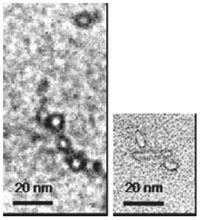Single Enzyme Nanoparticles Increase Catalyst Longevity for Months
(June 2004)

SENs on electron microscopic images
To increase the longevity and versatility of enzymes, PNNL scientists have caged single enzymes to create a new class of catalysts called SENs (single enzyme nanoparticles). The nanostructure protects the catalyst, allowing it to remain active for five months instead of the normal life span of just a few hours.
Converting free enzymes into novel enzyme-containing nanoparticles can result in significantly more stable catalytic activity. Working in the William R. Wiley Environmental Molecular Sciences Laboratory, researchers modified a common protein-splitting enzyme called alphachymotrypsin to make it soluble, then added vinyl reagents to introduce the growth of molecular threads, or polymers, from the enzyme surface. A second polymerization step cross-linked the silicon chains, forming a basketball-netlike structure a few nanometers thick.
What results are SENs that appear in electron microscopic images as hollow enzyme-containing nanostructures about 8 nanometers across. The porous netting preserves the shape of the enzyme inside yet allows its active site to interact with a substrate. Among the uses for SENs is the breakdown of toxic waste, and use in many types of biosensors for national security applications.
